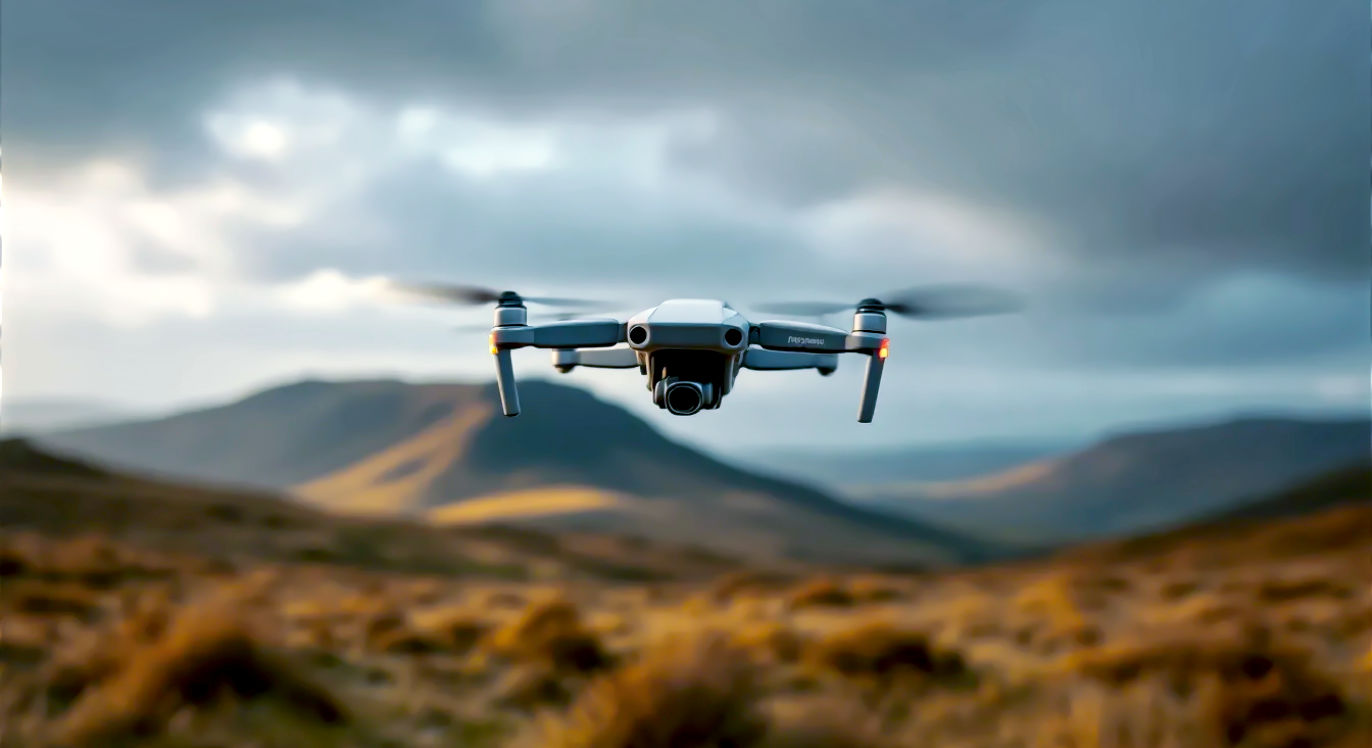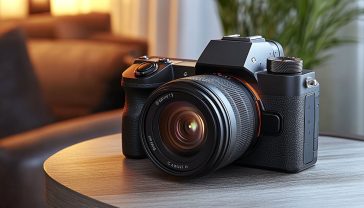DJI Mavic Pro: Is This Portable Drone Still a UK Favourite?
The DJI Mavic Pro changed the game, but how does it hold up today? We explore if this classic folding drone is still a top choice for UK hobbyists.

This post may contain affiliate links. If you make a purchase through these links, we may earn a commission at no additional cost to you.
Back in 2016, the world of drones was a bit like the world of mobile phones in the early noughties. You had chunky, slightly awkward bits of kit that were amazing for their time but weren’t exactly something you could just pop in your pocket. For aspiring aerial photographers and filmmakers across the UK, getting those stunning, swooping shots of the Scottish Highlands or the Cornish coast meant lugging around a hefty case with a big, white drone like the DJI Phantom. It was a serious commitment.
And then, everything changed.
DJI, the company that had already become the king of consumer drones, unveiled something that looked like it belonged in a sci-fi film. It was small, angular, and grey, and it folded down to the size of a water bottle. This was the DJI Mavic Pro. It wasn’t just a new drone; it was a revolution in a box. It promised the power of its bigger siblings in a package you could throw in a rucksack and take on a hike up Snowdon.
DJI Mavic 4 Pro Fly More Combo with DJI RC 2, Flagship Tri-Camera Drone with 100MP 4/3 CMOS Hasselblad Camera, 30km Video Transmission, 51-Min Max Flight…
-
High-Resolution Imaging: Equipped with a 100MP Hasselblad main camera, capturing 6K/60fps HDR video for vibrant, detailed aerial footage.
-
Advanced Zoom Capabilities: Features dual tele cameras for sharp, professional-grade zoomed shots, ideal for aerial photography.
-
Flexible Cinematic Shots: 360° Infinity Gimbal enables dynamic camera movements, perfect for creating cinematic drone footage.
-
Enhanced Night Safety: 0.1-Lux Nightscape Omnidirectional Obstacle Sensing ensures safe navigation and filming in low-light conditions.
-
Extended Flight Duration: Offers up to 51 minutes of flight time, supporting prolonged professional shoots.
-
Long-Range Video Feed: 30km O4+ transmission system delivers smooth 10-bit HDR video, ideal for mobile professionals.
-
Portable Pro Control: Includes a 7″ rotatable, high-brightness RC Pro 2 controller that collapses for easy transport and precise control.
-
Comprehensive Kit: Comes with DJI Mavic 4 Pro, DJI RC 2, three batteries, a charging hub, and additional accessories for extended flight sessions.
-
App Access Note: DJI Fly app is not available on Google Play; download the app and user manual from the official DJI website for optimal use.
For the first time, professional-grade aerial photography felt truly accessible to everyone. But that was years ago. In the fast-moving world of tech, the Mavic Pro is a pensioner. We’ve since had a flood of newer, smarter, and even smaller drones. So, the big question is, as we look at the market today, is the original game-changer still a worthy choice for hobbyists in the UK, or is it just a relic of a bygone era? Let’s find out.
What Was the Big Deal, Anyway? The Mavic Pro’s Magic Formula
To understand if the Mavic Pro still holds up, you first need to grasp why it was such a revelation. It wasn’t just one feature; it was the perfect blend of three key ingredients that no one had managed to nail before.
1. It Was Genuinely Portable
Before the Mavic Pro, “portable drone” was a bit of an oxymoron. Drones were fragile things with fixed arms that you had to transport in big, foam-lined cases. DJI’s masterstroke was designing a set of clever folding arms. The front arms swung back, and the rear arms flipped underneath, transforming the drone from a capable flying machine into a dense, compact brick that could easily fit into a camera bag or even a large coat pocket.
This single design choice changed everything. It meant you could take a powerful drone with you just in case you saw a beautiful sunset, rather than having to plan your entire day around carrying it. For British walkers, cyclists, and adventurers, this was the dream.
2. It Didn’t Compromise on Power
Usually, when you shrink something, you have to make sacrifices. But the Mavic Pro was packed with serious technology.
- A Cracking Camera: It had a camera capable of shooting sharp 4K video and 12-megapixel photos. For 2016, this was top-tier stuff. It meant the footage you captured was good enough for YouTube, professional client work, or just looking incredible on your big-screen telly.
- An Unbreakable Connection: It introduced a new transmission system called OcuSync. Think of it as a super-powered, military-grade Wi-Fi signal between the controller and the drone. While older drones relied on standard Wi-Fi, which could be flaky and cut out, OcuSync was rock-solid. It promised a crystal-clear video feed from miles away. While UK law never lets you fly that far, this powerful connection meant you had an incredibly reliable link, even when flying behind trees or over hillsides.
- Brains on Board: It was also clever. It had front-facing sensors to stop it from crashing into things and a bunch of “Intelligent Flight Modes.” These modes let you tap on your phone screen to make the drone automatically follow a person, circle a landmark, or fly along a pre-set path. It made getting cinematic shots much easier for beginners.
3. It Was Surprisingly Affordable
While it wasn’t cheap at around £1,000 on its launch, it was significantly less expensive than the bigger drones that offered similar performance. It hit a sweet spot that opened the door for thousands of hobbyists and small-time creators who had previously been priced out of the high-end drone market.
This combination of portability, power, and price was the magic formula. The Mavic Pro wasn’t just a drone; it was a creative tool that empowered a generation of filmmakers and photographers across Britain.
The Mavic Pro’s Core Specs: A Quick Refresher
Let’s quickly break down what’s under the bonnet. Even by today’s standards, the numbers aren’t too shabby.
| Feature | Specification | What It Means for You |
|---|---|---|
| Weight | 734g (or 743g with gimbal cover) | This is very important for UK drone laws today. It’s much heavier than the popular sub-250g drones. |
| Max Flight Time | Around 27 minutes (in perfect conditions) | In reality, expect about 20-22 minutes of usable flight time, which is still decent. |
| Camera Sensor | 1/2.3-inch CMOS, 12MP | Similar to a good smartphone camera from that era. Great in good light, struggles a bit in the dark. |
| Video Quality | 4K at 30fps, 1080p at 96fps | Shoots crisp, detailed 4K video. The high frame rate at 1080p is great for slow-motion shots. |
| Max Speed | 40 mph (in Sport Mode) | It’s surprisingly nippy and can handle a bit of British wind, but be careful. |
| Transmission System | OcuSync | A super-reliable video link to your controller. Less worry about losing connection. |
| Obstacle Sensing | Forward and Downward | It will stop itself from flying into a wall in front of it, but it has no side or rear sensors. |
Flying the Mavic Pro in the UK Today: The Rules Have Changed
This is arguably the most critical part of the conversation. When the Mavic Pro launched, the drone rules in the UK were a bit like the Wild West. Today, things are much stricter, and the Mavic Pro’s weight is its biggest handicap.
The Civil Aviation Authority (CAA) has a set of rules based on the weight of your drone. Because the Mavic Pro weighs 734g, it falls into a category with more restrictions than the newer, lighter drones.
Understanding the Open Category
Most hobbyist flying in the UK happens in the ‘Open Category’, which is split into subcategories. Without getting bogged down in legal jargon, here’s what you need to know for the Mavic Pro:
- It’s a ‘Legacy’ Drone: Because it was released before the current classification system, it’s considered a ‘legacy’ drone.
- A3 Subcategory is Your Default: For most people, you will have to fly it in the A3 subcategory. This means you must not fly it within 150 metres horizontally of residential, commercial, industrial, or recreational areas. In simple terms, you have to fly far from people. This immediately rules out flying in parks, towns, and built-up areas. You’re limited to the countryside, open fields, and remote coastlines.
- The Operator ID is a Must: You must register with the CAA as a drone operator (which costs a small fee) and display your Operator ID on the drone.
- The Flyer ID is Recommended: You should also pass the free online Flyer ID test to show you understand the basic rules.
Can I Fly it Closer to People? The A2 CofC Route
There is a way to get more freedom: by getting an A2 Certificate of Competency (A2 CofC). This is a paid course and exam that proves you have a better understanding of drone safety.
If you have an A2 CofC, you can fly the Mavic Pro in the A2 subcategory. This lets you fly it down to 50 metres horizontally from uninvolved people. You still can’t fly over them, but it gives you much more flexibility to fly in areas that aren’t completely empty.
The bottom line is simple: Flying the Mavic Pro legally in the UK today requires more planning and awareness than flying a sub-250g drone like the DJI Mini. You can’t just pop it up in your local park. You need to find wide-open spaces, or invest in the A2 CofC qualification.
How Good is the Camera in 2025?
So, you’ve found a legally safe spot to fly. You send the Mavic Pro up into the sky, overlooking the stunning Seven Sisters cliffs. Will the photos and videos still look good, or will they look like they were filmed on a potato?
The answer is: it depends on the light.
In bright, sunny conditions, the Mavic Pro’s camera can still produce absolutely beautiful results. The 4K video is sharp, and the colours are punchy. For posting on Instagram, making YouTube videos, or just showing off to your family, the quality is more than enough for most people. It punches well above its weight, especially for a second-hand price.
However, where it shows its age is in low light. As the sun starts to set, the small 1/2.3-inch sensor begins to struggle. The footage can look a bit grainy and soft. Newer drones, like the DJI Air 2S or Mavic 3, have much bigger sensors (like the difference between a compact camera and a big professional DSLR), which perform brilliantly as the light fades.
For professional photographers and videographers who need the absolute best quality in all conditions, the Mavic Pro is no longer the right tool. But for hobbyists who mainly fly during the day, its camera is still surprisingly capable and delivers fantastic value.
The Second-Hand Market: A Bargain Hunter’s Dream?
This is where the Mavic Pro becomes a really tempting option. You can now pick one up on websites like eBay, Facebook Marketplace, or specialist used-drone retailers for a fraction of its original price. You can often find a ‘Fly More Combo’—which includes extra batteries, a carrying case, and other useful bits—for under £300.
That’s an incredible amount of drone for the money. But buying second-hand comes with risks. Here are a few things to check if you’re looking to buy a used Mavic Pro in the UK:
- Battery Health: This is the most important check. Drone batteries degrade over time. Ask the seller for the charge cycle count for each battery (you can check this in the DJI app). A battery with over 100-150 cycles is getting old. Also, check for any swelling or damage to the battery casing. New batteries are expensive and hard to find.
- Check for Crashes: Inspect the drone’s arms, propellers, and body for any signs of cracks, deep scuffs, or repairs. A small scuff is fine, but major damage could indicate a serious crash that has caused hidden problems.
- Gimbal and Camera: The gimbal is the delicate motorised mount that keeps the camera steady. Check that it moves freely and smoothly when the drone powers on. Look at the camera lens for any scratches.
- See it Fly: If you can, always ask the seller for a quick flight demonstration. See it take off, hover steadily, and respond to the controls. Check that the video feed on the phone is clear and stable.
If you find a well-looked-after example, a second-hand Mavic Pro can be an absolute steal. It’s a brilliant gateway into the world of serious drones without breaking the bank.
The Mavic Pro’s Lasting Legacy
Whether you buy one or not, there’s no denying the Mavic Pro’s place in history. It completely changed the game and its DNA can be seen in almost every consumer drone that has come since.
- It made folding drones the standard. Every major DJI drone line since, from the Air to the Mini, uses a folding design. The Mavic Pro proved that portability was what people wanted.
- It pushed intelligent features forward. Features like ActiveTrack have been refined and improved, but the Mavic Pro made them mainstream.
- It created a new market. It democratised aerial imaging, giving a powerful new tool to everyone from estate agents wanting to capture stunning property shots to YouTubers looking to elevate their travel vlogs.
It was, and still is, a landmark piece of technology.
The Verdict: Is the DJI Mavic Pro Still a UK Favourite?
So, let’s circle back to our original question. After weighing up the rules, the camera quality, and the competition, is the Mavic Pro still a smart buy in the UK?
The answer is a definite yes, but with a few big ‘ifs’.
The DJI Mavic Pro is still a fantastic drone if:
- You are on a tight budget. It offers unbeatable value on the second-hand market.
- You understand and are willing to follow the UK’s drone regulations. This means flying in wide-open spaces (A3) or getting your A2 CofC.
- You primarily fly in good daylight. Its camera is still brilliant when the sun is out.
- You are a beginner looking to learn the ropes before investing in a more expensive, modern drone.
However, the Mavic Pro is probably not for you if:
- You want the simplest possible experience with the fewest legal restrictions. In that case, a sub-250g drone like the DJI Mini 3 or 4 Pro is a much better choice.
- You need professional-grade image quality, especially in low light.
- You are nervous about buying second-hand tech.
The Mavic Pro is no longer the king of the skies. It’s been overtaken by drones that are lighter, have better cameras, and more safety features. But it has gracefully transitioned into a new role: it’s the perfect ‘modern classic’. Like a well-maintained older sports car, it might lack some modern comforts and require a bit more skill from its owner, but it still delivers a thrilling experience and fantastic results.
For those willing to embrace its quirks and respect the rules, the original pocket powerhouse remains one of the best-value creative tools you can buy. A true UK favourite? For a certain type of pilot, absolutely.
Further Reading & Official Resources
For anyone considering flying a drone in the UK, it’s essential to stay up-to-date with the official rules and regulations.
- UK Civil Aviation Authority (CAA) – Drone and Model Aircraft Section: The official source for all UK drone laws. https://www.caa.co.uk/drones/
- Drone Scene: A fantastic resource for UK drone pilots, offering a map of safe places to fly, flight restriction zones, and a community forum. https://dronescene.co.uk/
- Drone Assist: An app that helps you check for flight restrictions and ground hazards. Drone Assist App (iOS)







